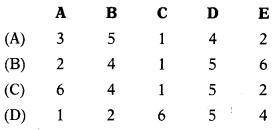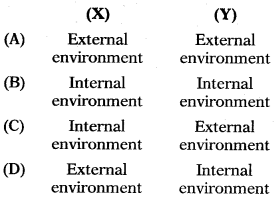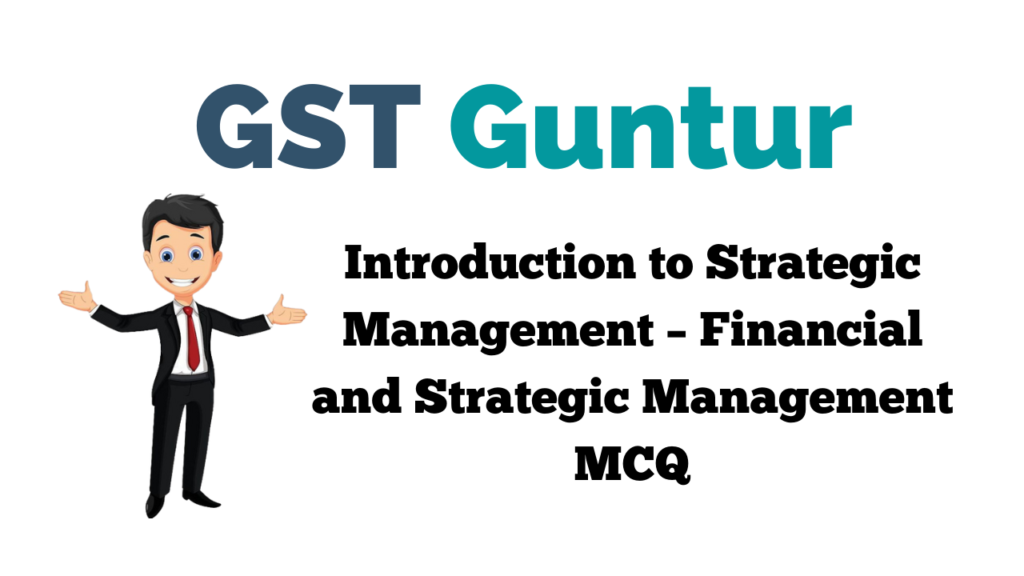Students should practice Introduction to Strategic Management – CS Executive Financial and Strategic Management MCQ Questions with Answers based on the latest syllabus.
Introduction to Strategic Management – Financial and Strategic Management MCQ
Question 1.
We may define the term ‘Strategy’ as a blueprint.
(A) Long-range
(B) Short-range
(C) Short and medium-range
(D) Unlimited rage
Answer:
(A) Long-range
Question 2.
Strategic management involves the decision-making and the activities in an organization which –
(A) Have wider ramifications
(B) Have a long time perspective
(C) Use critical resources towards perceived opportunities or threats in a changing environment
(D) All of the above
Answer:
(D) All of the above
Question 3.
According to Chandler ‘Strategic Management’ is –
(A) That set of decisions and actions lead to the development of an effective strategy or strategies to help achieve corporate objec¬tives.
(B) The formulation and implementation of the major goals and initiatives taken by a company’s top management.
(C) Determination of the basic long-term goals and objectives of an enterprise and adoption of course of action and allocation of resources necessary to carry out these goals.
(D) Developing the company’s vision, environmental scanning, strategy formulation, implementation and evaluation, and control.
Answer:
(C) Determination of the basic long-term goals and objectives of an enterprise and adoption of course of action and allocation of resources necessary to carry out these goals.
Question 4.
According to Glueck ‘Strategic Management’ is a set of decisions and actions which lead to the development of an effective strategy or strategies to help achieve___
(A) Major objectives
(B) Planning objectives
(C) Corporate objectives
(D) National objectives
Answer:
(C) Corporate objectives
Question 5.
According to Hambrick Strategic Management’ Strategic management are the formulation and implementation of the taken by a company’s top management on behalf of owners, based on consideration of resources and an assessment of the internal and external environments in which the organization competes.
(A) Major goals and initiatives
(B) Major plans and process
(C) Major decisions
(D) Product development
Answer:
(A) Major goals and initiatives
Question 6.
Strategic management involves developing the –
I. Company’s vision
II. Training of personnel in. Environmental scanning
IV. Strategy formulation
V. New software
VI. Strategy implementation
Select the correct answer from the options given below.
(A) I, III & IV only
(B) IV, III, I & VI
(C) I and IV only
(D) Except V all
Answer:
(B) IV, III, I & VI
Question 7.
Strategic management emphasizes the monitoring and evaluation of external opportunities and threats in
the light of a company’s and designing strategies for the survival and growth of the company.
(A) Plans and budget
(B) Asset and liabilities
(C) Strengths and weaknesses
(D) Opportunities and plans
Answer:
(C) Strengths and weaknesses
Question 8.
According to Chandler ‘Strategic Management’ is the determination of the basic long-term goals and objectives of an enterprise and the adoption of a course of action and allocation of___necessary to carry out this goal?.
(A) Sources
(B) Resources
(C) Assets
(D) Expenses
Answer:
(B) Resources
Question 9.
Arrange the process of strategic management in proper sequence –
P. Where we want to be?
Q. How can we ensure arrival?
R. How might we get there?
S. Where are we now?
T. Which way is best?
Select the correct answer from the options given below.
(A) S, P, R, T, Q
(B) S, T, R, P, Q
(C) P, R, S, T, Q
(D) R,S,P,Q,T
Answer:
(A) S, P, R, T, Q
Question 10.
Match the List I with List II with reference to the strategic management process:
| List I | List II |
| A. Where we want to be? | 1. Means |
| B. Where are we now? | 2. Control |
| C. How can we ensure arrival? | 3. Plans |
| D. How might we get there? | 4. Beginning |
| E. Which way is best? | 5. Evaluation |
| 6. Ends |
Select the correct answer from the options given below.

Answer:
(C)
Question 11.
Out of all the alternatives generated in the earlier stage, the organization selects the best suitable alternative. This stage in the strategic management process is called as___
(A) Evaluation
(B) Means
(C) Ends
(D) Beginning
Answer:
(A) Evaluation
Question 12.
The strategic management process is defined as the process by which the managers are able to make a choice of a set of strategies for the organization that will enable it to accomplish –
(A) Targeted marketing plans
(B) Improved performance
(C) Better debt-equity ratio
(D) Government help
Answer:
(B) Improved performance
Question 13.
Strategic management ___
(A) Is not a static
(B) Is a continuous process
(C) Consists of different phases
(D) All of the above
Answer:
(D) All of the above
Question 14.
There are____ indispensable phases of every strategic management process.
(A) Five
(B) Four
(C) Six
(D) Three
Answer:
(B) Four
Question 15.
Which of the following is the first phase of the strategic management process?
(A) Strategy Formulation
(B) Strategy Evaluation
(C) Strategy Implementation
(D) Environmental Scanning
Answer:
(D) Environmental Scanning
Question 16.
Environment scanning is careful monitoring of an organization’s environment for detecting early signs of opportunities and threats that may influence its current and future plans.
(A) Internal
(B) External
(C) Internal and external
(D) Internal or external
Answer:
(C) Internal and external
Question 17.
Which of the following are/are NOT features of the business environment?
(I) Uncertainty
(II) Relativity
(III) Static Nature
Select the correct answer from the options given below
(A) (I) only
(B) (II) only
(C) (III) only
(D) None of the above
Answer:
(C) (III) only
Question 18.
Which of the following describes the desired future position of the company?
(A) Vision statement
(B) Mission statement
(C) Planning statement
(D) Forecasting statement
Answer:
(A) Vision statement
Question 19.
Which of these basic questions should a vision statement answer?
(A) What is our business?
(B) Who are our competitors?
(C) Where we are to go?
(D) Why do we exist?
Answer:
(C) Where we are to go?
Question 20.
Which of the following is the beginning stage of the strategic management process?
(A) Process of goal setting for the organization after it has finalized its vision and mission.
(B) The organization selects the best suitable alternative.
(C) Firm finds out its relative market position, corporate image, its strength and weakness, and also threats and opportunities.
(D) The organization deals with the various strategic alternatives it has.
Answer:
(C) Firm finds out its relative market position, corporate image, its strength and weakness, and also threats and opportunities.
Question 21.
A defines the company’s business, its objectives, and its approach to reach those objectives.
(A) Vision statement
(B) Mission statement
(C) Planning statement
(D) Forecasting statement
Answer:
(B) Mission statement
Question 22.
According to Porter, what is usually the most powerful of the five compet¬itive forces?
(A) Rivalry among existing firms
(B) Potential development of substitute products
(C) Bargaining power of buyers and suppliers
(D) Potential entry of a new competitor
Answer:
(A) Rivalry among existing firms
Question 23.
Mission and Vision Statements are NOT commonly used to:
(A) Guide management’s thinking on strategic issues, especially during times of significant change
(B) Create wider linkages with customers, suppliers, and alliance partners
(C) Help establish a framework for ethical behavior
(D) Inspire employees to work more productively by providing focus and common goals
Answer:
(B) Create wider linkages with customers, suppliers, and alliance partners
Question 24.
A business has absolute control in the……….(X), whereas it has no control over the…………..(Y)
Select the correct answer from the options given below.

Answer:
(C)
Question 25.
What type of organizational struc¬ture do most small businesses follow?
(A) Divisional Structure
(B) Functional Structure
(C) Hour Glass Structure
(D) Matrix Structure
Answer:
(D) Matrix Structure
Question 26.
There are mainly two types of business environment –
(A) Internal and external
(B) Internal and operational
(C) Operational and external
(D) Matrix and diagonal
Answer:
(A) Internal and external
Question 27.
The environment is complex. Which of the following supports this?
(A) Customers are the people who pay money to acquire an organization’s products.
(B) The environment consists of a number of factors, events, conditions, and influences arising from different sources and it is somewhat easier to understand in parts but difficult to grasp in totality.
(C) A study of the competitive scenar¬io is essential for the marketer, particularly threats from com¬petition.
(D) If a supplier provides poor service, this could increase times¬cales or lower product quality.
Answer:
(B) The environment consists of a number of factors, events, conditions, and influences arising from different sources and it is somewhat easier to understand in parts but difficult to grasp in totality.
Question 28.
The operational strategy focuses on issues of
(A) Resources
(B) Processes
(C) People
(D) All of above
Answer:
(D) All of above
Question 29.
Which of the following is a characteristic of the business environment?
(A) Environment is complex.
(B) Environment is dynamic.
(C) Environment is multi-faceted.
(D) All of the above
Answer:
(D) All of the above
Question 30.
The microenvironment is also known as –
(A) General Environment
(B) Global Environment
(C) Task environment
(D) Matrix environment
Answer:
(C) Task environment
Question 31.
The Porter’s Forces tool is a simple but powerful tool to evaluate the power of business.
(A) Four
(B) Five
(C) Six
(D) Ten
Answer:
(B) Five
Question 32.
The microenvironment has an influence on the business.
(A) Indirect
(B) Direct
(C) Negative
(D) Minor
Answer:
(B) Direct
Question 33.
According to Michael Porter, the essence of strategy formulation is
(A) Mapping the Five Forces
(B) Developing core competences
(C) Coping with competition
(D) Balancing stakeholder interests
Answer:
(C) Coping with competition
Question 34.
Which of the following is an element of the microenvironment?
(A) Demographic Environment
(B) Competitors
(C) Socio-cultural factors
(D) Economic terms
Answer:
(B) Competitors
Question 35.
Porter’s Five Forces tool is a simple but powerful tool to evaluate the power of business. Which of the following is not one of the five?
(A) Bargaining power of suppliers
(B) Bargaining power of customer
(C) Rivalry among current players
(D) None of the above
Answer:
(D) None of the above
Question 36.
Assertion (A):
Porter’s five forces model considers new entrants as a significant source of competition.
Reason (R):
New capacity and product range that the new entrants bring in throw up new competitive pressure. Bigger the new entrant, the more severe the competitive effect. New entrants also place a limit on prices and affect the profitability of existing players.
Select the correct answer from the options given below.
(A) A is false and R is true explaining how A is false
(B) Both A and R are true and R is the correct explanation of A.
(C) A is true and R is false
(D) Both A and R are true
Answer:
(B) Both A and R are true and R is the correct explanation of A.
Question 37.
The business strategy focuses on:
(A) Strategies related to functional areas such as Marketing, Production, and HRM.
(B) Where a firm is going and the scope of its activities.
(C) How a firm competes within a particular market or industry.
(D) How to allocate resources between different parts of the business
Answer:
(C) How a firm competes within a particular market or industry.
Question 38.
Porter’s notion of a differentiation strategy is best described as one in which firms seek a competitive advantage:
(A) Through having a lower cost than their competitors.
(B) Through establishing their uniqueness.
(C) Through concentrating on a narrow market segment.
(D) Through achieving a match between their internal and external environments
Answer:
(B) Through establishing their uniqueness.
Question 39.
Which of the following is not an element of Porter’s 5 Forces Model?
(A) The bargaining power of suppliers.
(B) The firm’s existing competition.
(C) The firm’s macro-economic environment.
(D) The potential competition from new entrants.
Answer:
(C) The firm’s macro-economic environment.
Question 40.
Porter’s Value Chain is essentially a tool for:
(A) Identifying the competitive forces within an industry.
(B) Advising firms on how to price their products.
(C) Diagnosing and enhancing sources of competitive advantage within an organization.
(D) Calculating what a firm is worth.
Answer:
(C) Diagnosing and enhancing sources of competitive advantage within an organization.
Question 41.
In Porter’s five forces model, con¬ditions are more favorable for firms within an industry if:
(A) Buyer power is high
(B) Supplier power is high
(C) Entry threat is low
(D) Substitute threat is high
Answer:
(C) Entry threat is low
Question 42.
If a firm takes over a competitor then, according to Porter’s 5 forces model:
(A) Buyer power is higher
(B) Supplier power is higher
(C) Substitute threat is higher
(D) Rivalry is lower
Answer:
(D) Rivalry is lower
Question 43.
Which of the following is not a force in the Porter Five Forces model?
(A) Buyers
(B) Suppliers
(C) Complementary products
(D) Industry rivalry
Answer:
(C) Complementary products
Question 44.
According to Porter, suppliers are more able to exercise bargaining power over buyers when:
(A) The supply industry is dominated by a few large firms.
(B) The supply industry is populated by a large number of small firms.
(C) When buyers have the ability to take over suppliers.
(D) There are few buyers in the market
Answer:
(A) The supply industry is dominated by a few large firms.
Question 45.
Which core competencies are required for a Company Secretary to become an effective player of strategic management?
(a) Communication and professional skills, legal skills, management skills, and IT skills.
(b) Updated knowledge of legal envi¬ronment, financial environment & business environment.
(c) Ability to work and achieve a con¬sensus within multidisciplinary settings.
(d) Remaining calm under pressure and not losing sight of perspective.
Select the correct answer from the
(A) (a) and (b)
(B) (b)and(c)
(C) (a)and(c)
(D) All (a) to (d)
Answer:
(D) All (a) to (d)
Question 46.
Potential rivals will not find it difficult to enter a market where: 10
(A) Existing firms have long-term contracts with the biggest customers.
(B) Product differentiation is very strong.
(C) Existing firms have the ability to retaliate strongly.
(D) Economies of scale are insignificant
Answer:
(D) Economies of scale are insignificant
Question 47.
According to Porter, which of the following is most important to achieving competitive advantage?
(A) Serving all customers equally, rather than targeting the most profitable.
(B) Operating at lower cost, commanding a premium price, or both.
(C) Focusing on becoming the most competitive business within the sector/market.
(D) Outsourcing activities that enhance/refine your competitive advantage
Answer:
(B) Operating at lower cost, commanding a premium price, or both.
Question 48.
Identify which of the following forces does not form part of Porter’s Competitive Position Analysis?
(A) Buyer power
(B) Risk of losses
(C) Threat of new entry
(D) Supplier power
Answer:
(B) Risk of losses
Question 49.
What is likely to happen if many new businesses enter a market?
(A) Barriers to entry will rise.
(B) Industry capacity will fall.
(C) Competitive rivalry will intensify.
(D) Industry profits will increase.
Answer:
(C) Competitive rivalry will intensify.
Question 50.
In Porter’s five forces model, what is meant by the term ‘substitute?
(A) A substitute refers to an alternative manufacturing process.
(B) A substitute is an alternative prod¬uct or service that performs the same function for the consumer.
(C) A substitute is a rival firm offering the same products.
(D) A substitute is something else consumers would rather spend their money on.
Answer:
(B) A substitute is an alternative product or service that performs the same function for the consumer.
